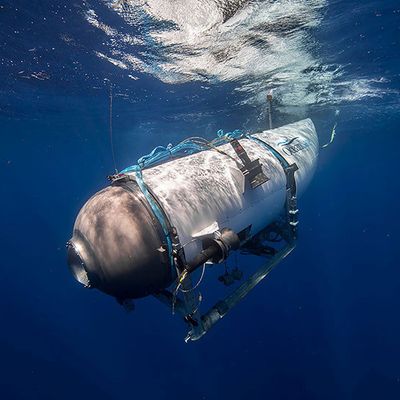
The Coast Guard announced at a press conference on Thursday that debris from the submersible Titan was found on the seafloor near the Titanic, confirming the deaths of the five crew members onboard.
While searching an area of flat seabed approximately 1,600 feet from the bow of the Titanic, a remotely operated vehicle discovered “five major pieces of debris that told us it was the remains of the Titan,” said undersea expert Paul Hanken, including the front end of the pressure hull. “That was the first indication that it was a catastrophic event.”
The location of the debris suggested that the submersible imploded around the time it lost contact on Sunday, an hour and 45 minutes into its dive. The tremendous pressure the submersible experienced at those depths means that even a pinprick failure in the pressure hull would have cascaded almost instantly into a lethal implosion.
Gary Lang, a television and film director who worked with James Cameron on his documentary film about the wreck of the Titanic and dove in a submersible to the wreckage as part of that project, says everyone onboard was made to understand that if anything went wrong, death would be instantaneous. “A pinprick would turn into a gaping wound in less than a second.” Given the tremendous pressure, he says, “at that point, you’re not even mush.”
Given the nature of the sub’s demise, it now seems likely that the “banging” sounds rescuers heard over the past two days did not actually come from the occupants of the submersible, who would have been long dead by then. The ocean, though it can often seem placid from the surface, is full of noises both natural and man-made, and these can often mislead underwater searchers. During the search for MH370, crews spent weeks trying to track down pings that were believed to come from the downed plane’s black boxes but that turned out to be nothing.
Asked if the bodies could be recovered, Rear Admiral John Mauger, the leader of the search, said, “This is an incredibly unforgiving environment,” and reiterated that the vessel had suffered a “catastrophic implosion,” implying that there might not be much left to recover.
In an interview on ABC News, ocean explorer Robert Ballard, who discovered the wreck of the Titanic in 1985, suggested that Titan’s innovative carbon-fiber pressure hull might have been to blame for the vessel’s loss. “We’ve made thousands and thousands of dives with different vehicles” since 1960, Ballard said, “and we’ve never, ever, in the history of these extreme-deep-diving programs, ever lost a vehicle. So this is a first. So you naturally go to, How does this vehicle differ from the vehicles we’ve been using for many years? And it did have a very experimental hull, and obviously that hull imploded.”
More From This Series
- Recovered Titan Debris Includes ‘Presumed Human Remains’
- What I Learned on a Titanic Sub Expedition
- What We’ve Learned From the Titanic Sub Disaster






























